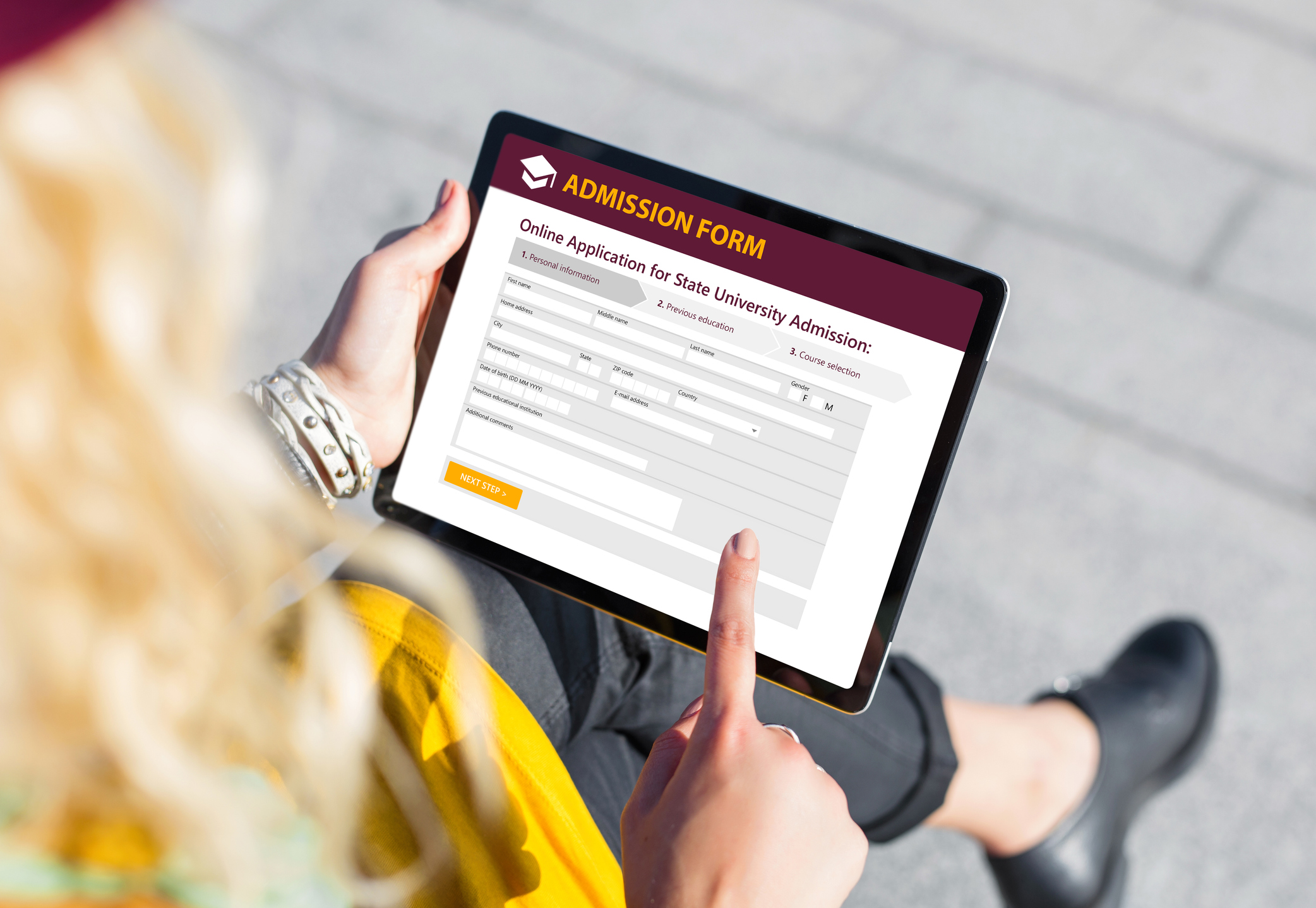2021 has been an eventful year for student recruitment. New technologies, events, and revised frameworks are pushing us forward towards a more promising year—giving schools around the world plenty of opportunities to boost student enrolment numbers.
Although student recruitment marketing is not always straightforward, it can introduce innovative ways to showcase your school, enhance prospects’ learning journey, and even improve the student admissions process. That’s because student recruitment doesn’t end once you attract interested prospects, but rather when they complete their admission process.
A recent survey conducted by the Institute of International Education (IIE) reveals that 43% of institutions have reported double the growth of international student applications for the 2021/22 academic year compared to the previous year. These expectations also align with Common App’s own , which projects an 18.6% increase in application volumes from 2019-20 to 2021-22.
As more students create accounts on student application portals and apply, your school can leverage these technologies to retain applicants and help support them throughout their enrolment journey. With the right strategies in place, interested prospects can be effectively guided along to complete their application for consideration to join your school’s community. Here are some approaches that you can adopt to help boost your school’s efforts.

1. Highlight Your Flexibility by Digitizing the Student Application Process
The process of applying to a new school or program should always be intuitive and simple. Otherwise, prospects may be stall or be deterred from continuing with their application. As technology continues to advance and play an even bigger role in the education sector, it becomes increasingly more important for your school to stay up to date. Digitizing the admissions process can help your school maintain its competitive edge in today’s highly digital student recruitment landscape.
Going digital provides your admissions team with countless benefits, enabling your school to streamline its enrolment efforts while embracing the flexible nature of digital applications. Interestingly, flexibility in admissions was listed among the top three enrolment factors by over 1200 agents in ICEF Agent Voice’s recent survey—making it an important factor for your school to consider implementing in 2022.
The ease of creating an account and applying online via a student application portal can be a deciding factor for prospects seeking a quick and painless admission process. Adding an “Apply” call-to-action (CTA) on the website and redirecting prospects to the application portal is a simple yet effective way to highlight your digital admissions process.
Example: The Webster University homepage features an “Apply” CTA at the top right corner that is always visible and accessible. When clicked, prospects are taken to the school’s application portal page.
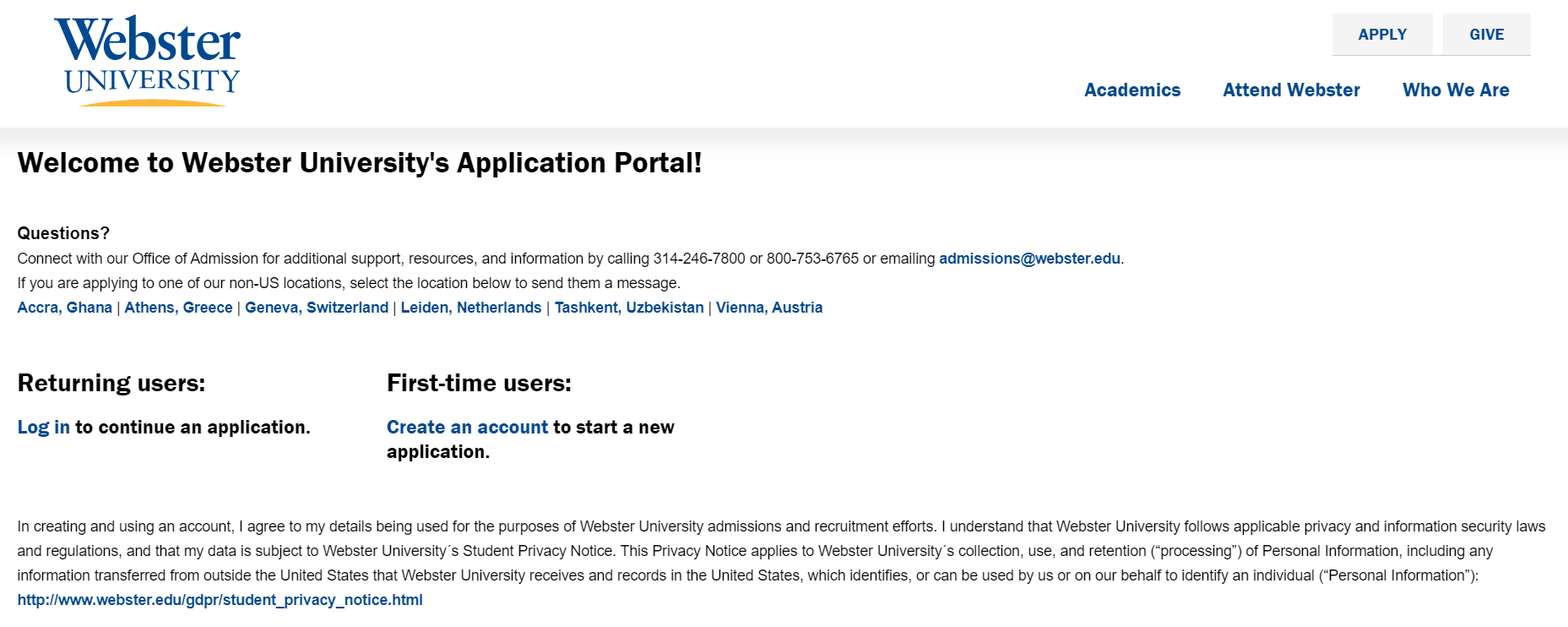
Source: Webster University
By choosing a flexible student portal, your school can offer prospects different options to better address their needs—enabling document uploads and digital signatures as well as creating custom forms specifically tailored to your school and its admissions process.
Remove Potential Boundaries to Boost Accessibility
Student admission policies have changed over the course of the past few years, with more emphasis placed on maximizing accessibility and breaking down barriers. According to Inside Higher Ed’s 2021 survey, about half of the polled admissions officials report a change in their application process—becoming test-optional or test-blind.
Test-optional colleges make it so that students can choose whether or not to submit their SAT or ACT scores as part of their application, while test-blind colleges choose not to review test scores even if they were submitted. In doing so, 47% have reported an increase in applications from underrepresented minority students. That is to say, flexible admissions policies can attract more students and portray your school as more inclusive than other options.
Example: The University of Edinburgh dedicates a page on its website for information regarding wider access offers, as seen below:
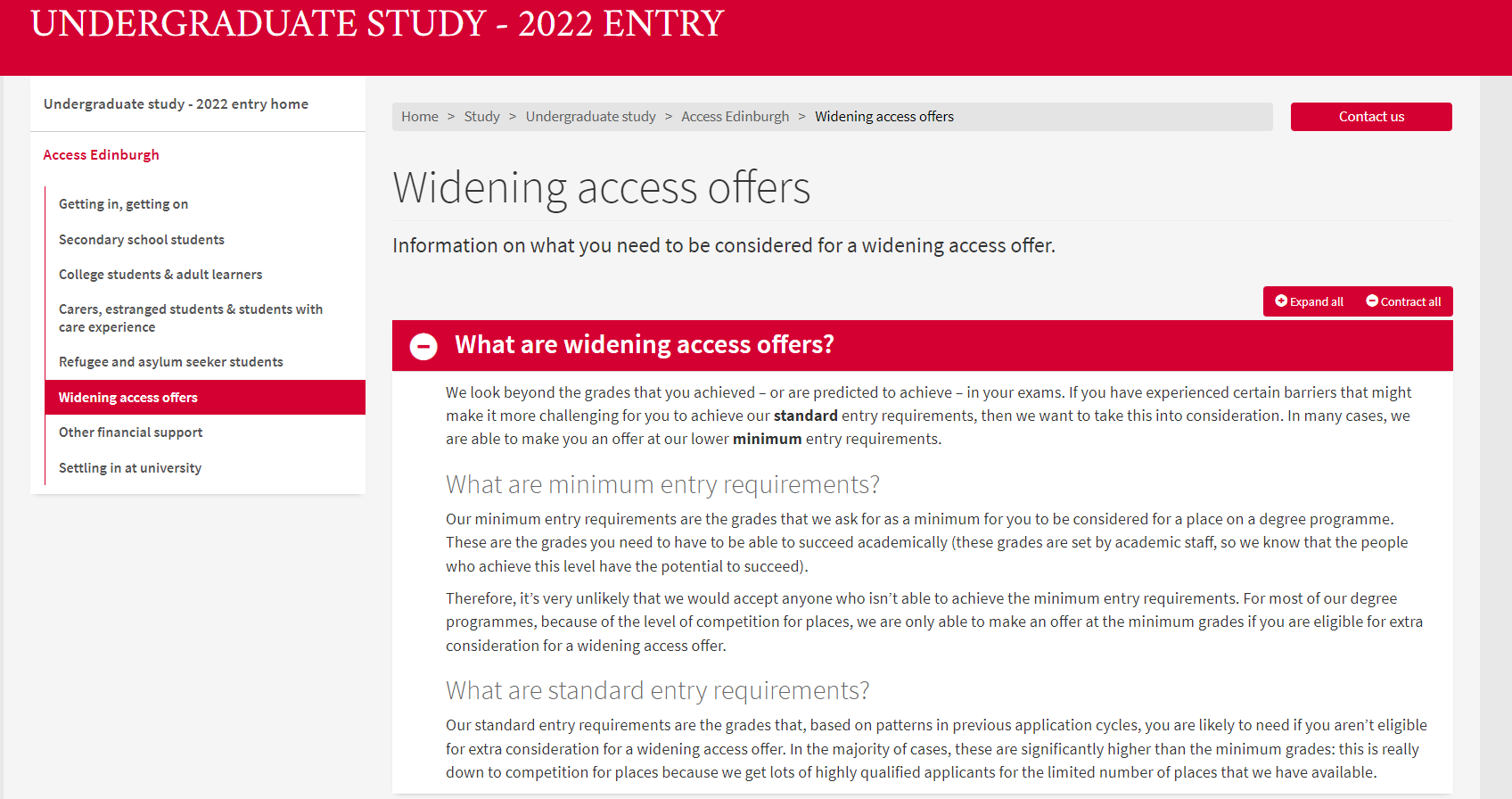
Source: The University of Edinburgh
Schools can also adopt a customizable student application portal to personalize their enrolment experience and cater to the applicant’s unique needs—thereby removing any potential boundaries. A powerful student portal provides schools with the chance to design and tailor the application form, enabling custom fields so that schools can ask for the information that they need while creating opportunities for more inclusivity.
The image below showcases how these custom fields can be used by schools to personalize the admissions process. Here, your school can determine how each field appears and how it functions within the overall student application form. In this way, you can promote efficiency and a positive student experience on your platform.
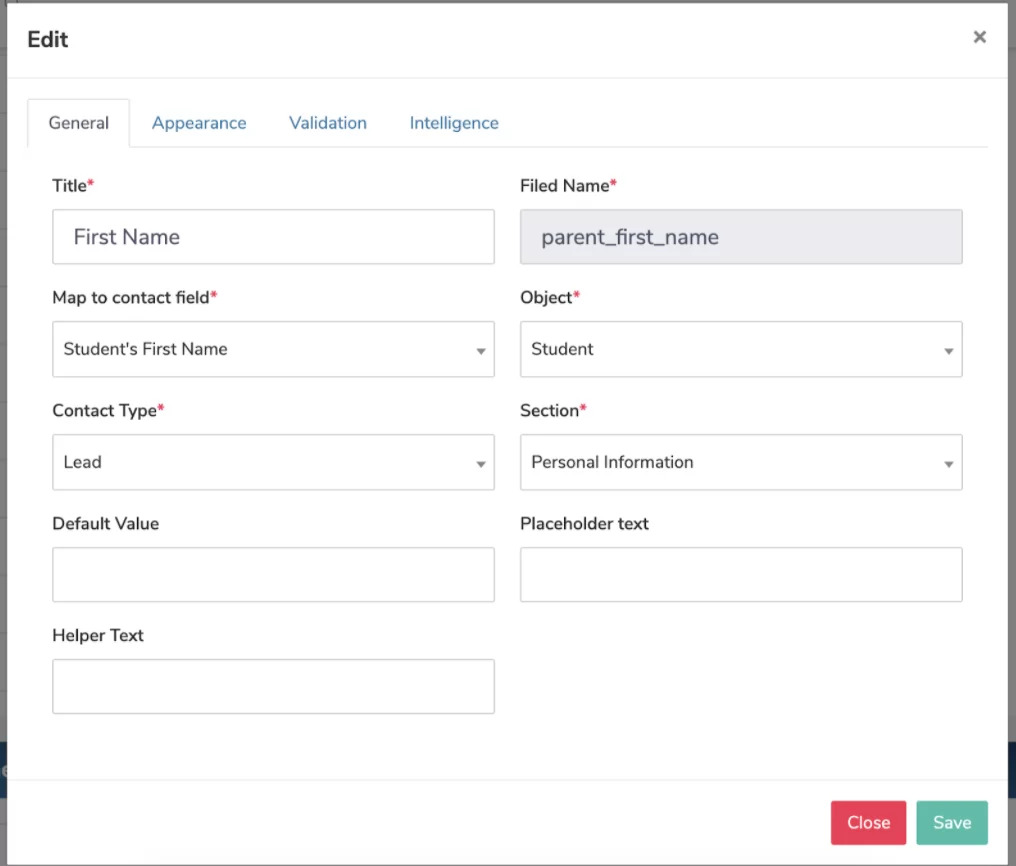
Source: HEM’s Student Portal
Consider Integrating an Education-Focused CRM
Integrating a powerful CRM should also be part of your school’s digitization efforts. A CRM designed with the needs of the education sector in mind can streamline your admissions team’s efforts and even boost their productivity. Here, your team can easily manage new relationships with interested prospects and integrate data gathered into your student application portal. With this technology, you can create more effective outreach efforts and strengthen your recruitment strategy.
2. Introduce a Virtual Admissions Assistant in Your Student Application Portal
Completing an application may take multiple steps to achieve. While completing their application, your prospects may realize that they need to submit additional documentation or information that they don’t have on hand. This may prompt them to pause and even leave your portal environment—interrupting their flow, prolonging the submission, and risking abandonment of the application. With HEM’s proprietary Virtual Admissions Assistant (VAA) tool, which can be integrated into the student application portal, your school can ensure that key information is made available and easily accessible in that critical moment.
By using this handy online tool, schools can keep leads and applications flowing remotely. That’s because it’s specifically designed to help prospects plan their own studies and connect directly with their chosen school. The VAA tool can also be used to save your admissions team’s time, giving prospects access to helpful resources and information. This particular feature can make it an effective tool for digital student recruitment, encouraging faster enrolments.
Example: The University of the Commonwealth Caribbean uses the VAA tool to display information about its campus (first image) and programs (second image). Here, students can easily access key information in an intuitive and step-by-step format that naturally leads them towards a completed application.
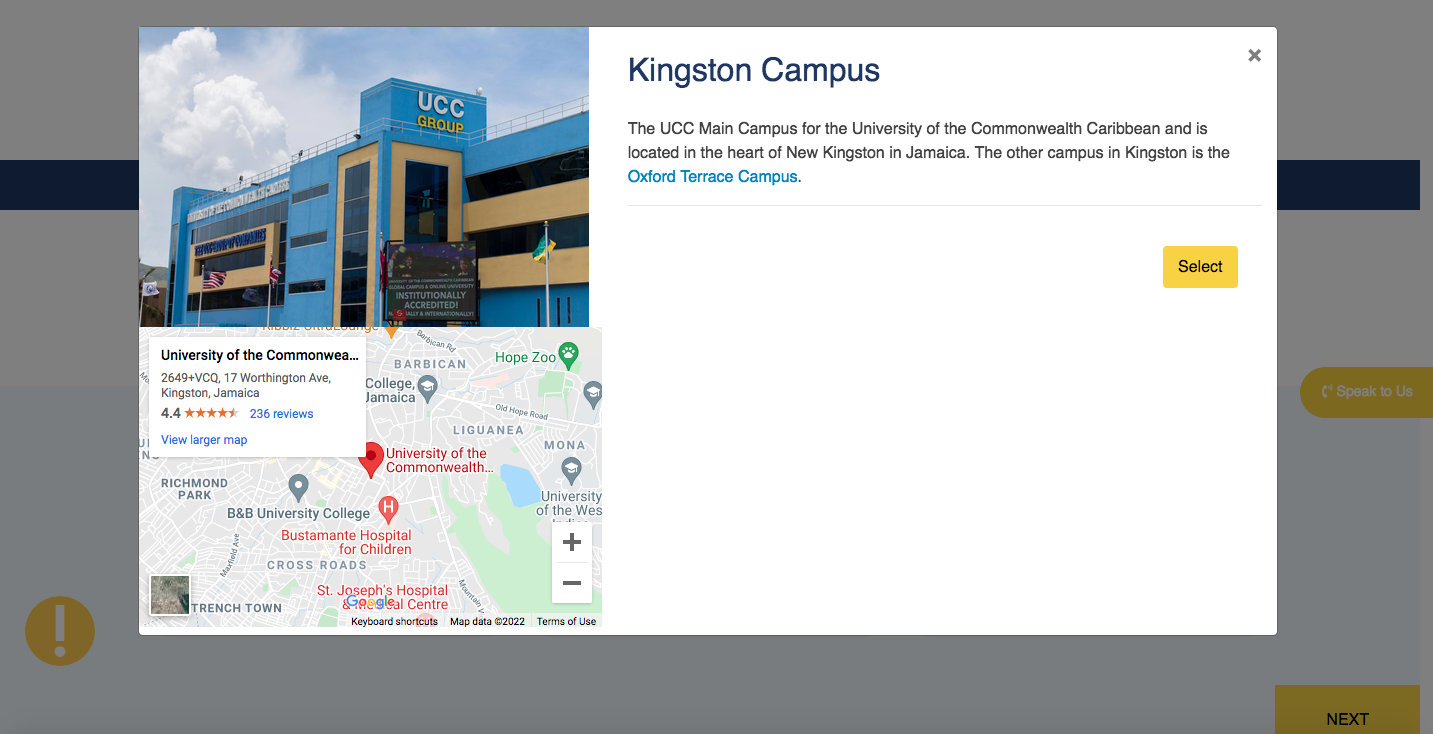
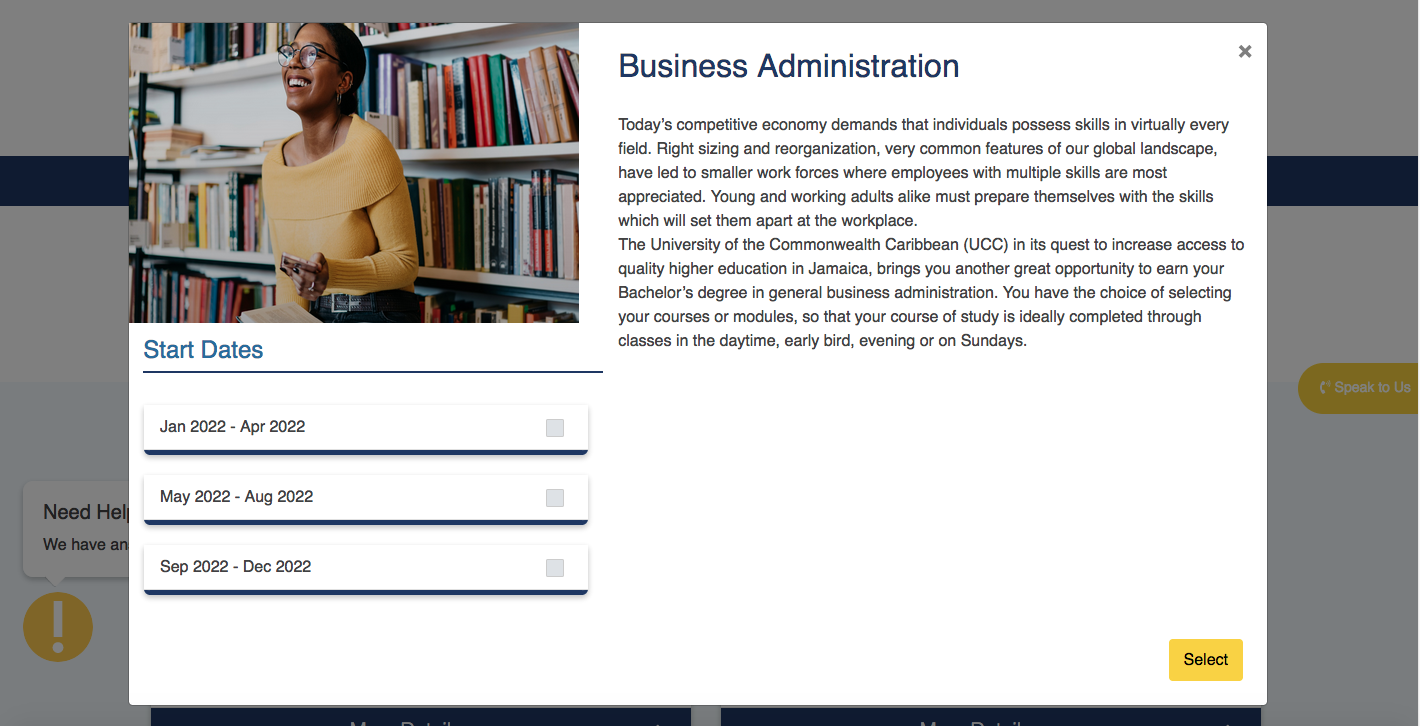
Source: The University of the Commonwealth Caribbean
Schools can also use the VAA to introduce financial services, application requirements, and other relevant information. In this way, prospects can review everything they need to know all while staying in the student portal—making it easier for your team to retain their interest and motivation.
Build Personal Connections by Providing Value
Completing an online application can sometimes be difficult, and your prospects may have some questions they would need to be answered in order to proceed. To give your school a leg up in this process, you’ll want to ensure that you remain accessible and available. This is where your school can provide contact details to answer any questions prospects may have, engaging them throughout the admissions process and adding value to their experience.
Consider adding a phone number and email address—going a step further to make those links active for an instant connection. The New York Film Academy places contact information at the very top of its application forms. This makes it easy for students to contact the admissions team for extra support. Through this call, prospects can build deeper connections with the school and feel like their needs are personally addressed.
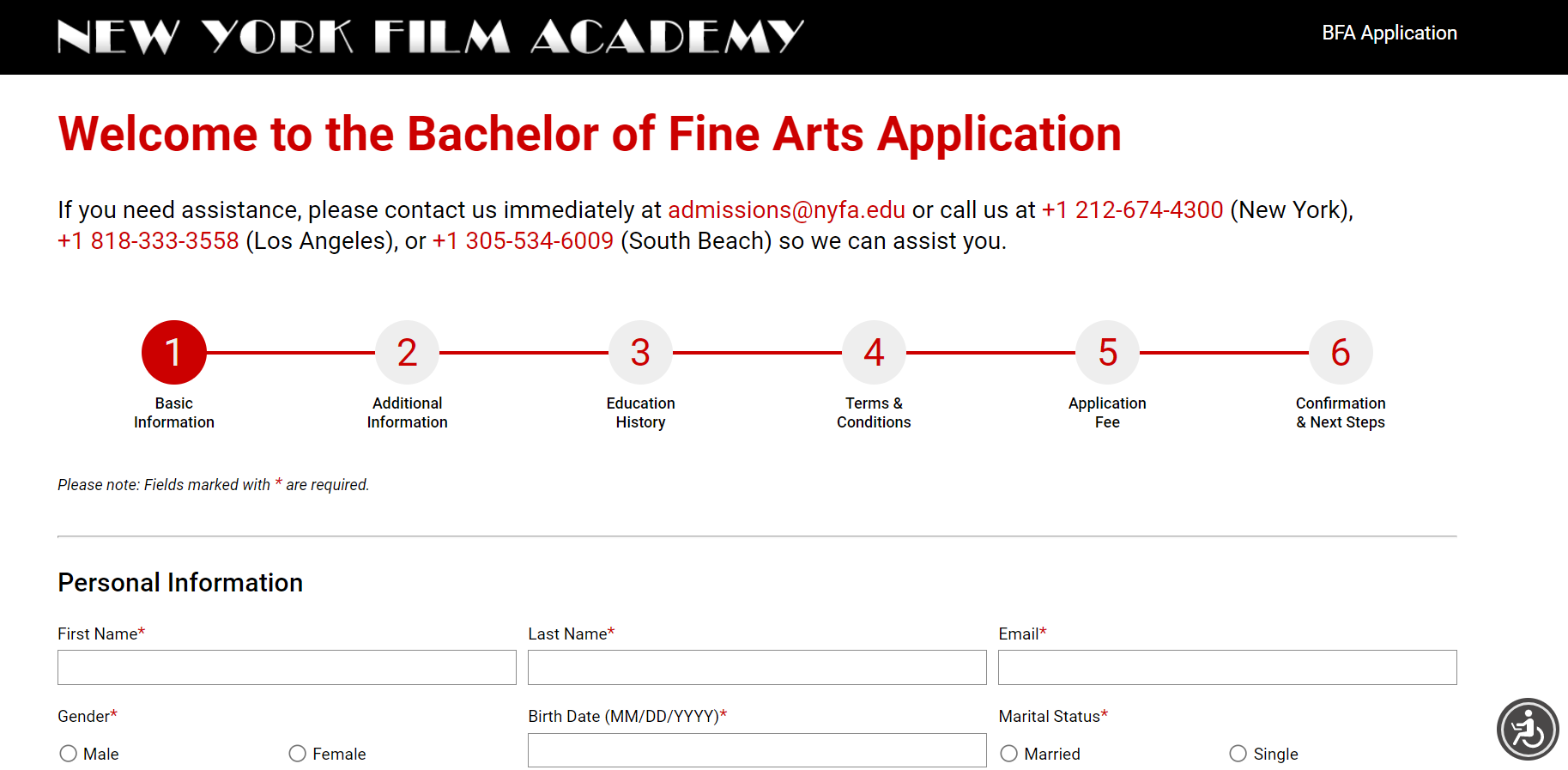
Source: The New York Film Academy
By using HEM’s proprietary Student Portal, you can even create a “Request to Call” function that allows prospects to immediately share their phone number for a personal follow-up. The image below showcases a popup form that prospects can quickly fill out to get started:
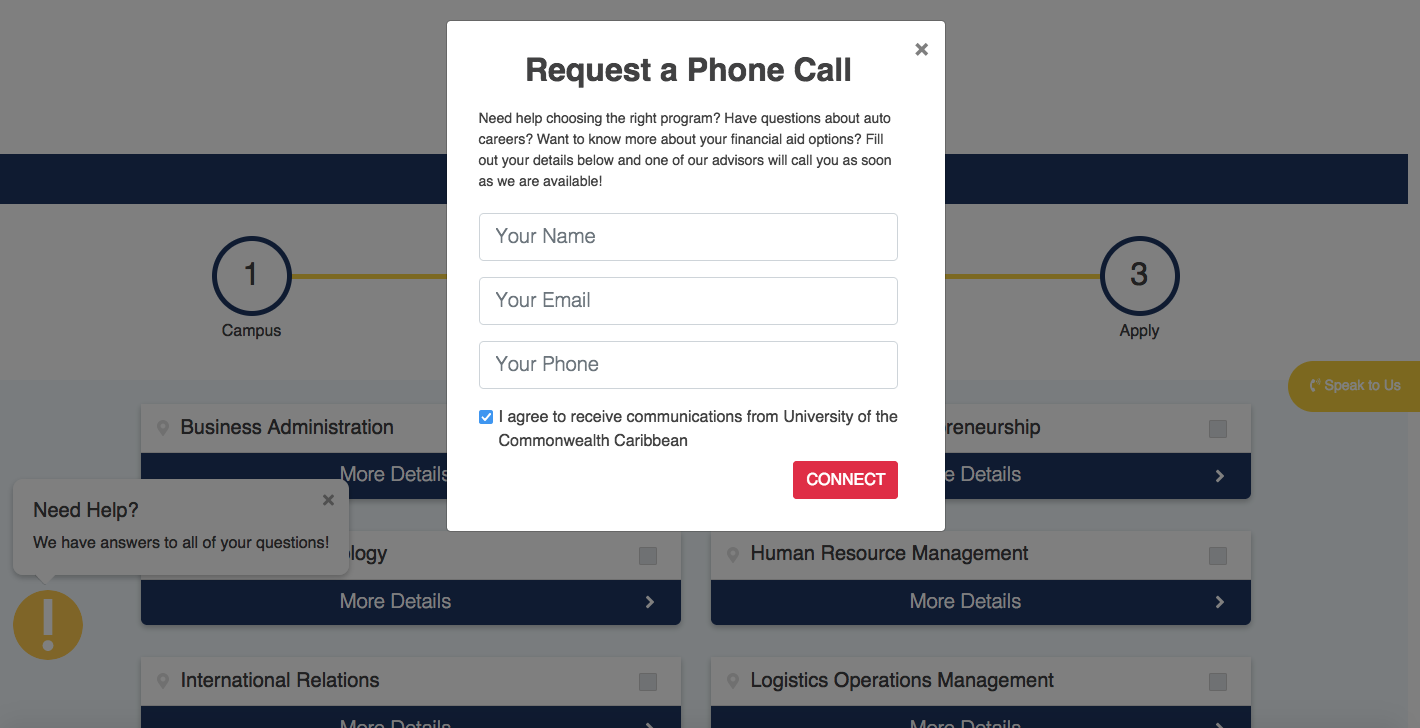
Source: HEM’s Student Portal
Your admissions team will receive a notification and be able to directly answer and help students, playing an even bigger role in their decision-making process. Enhancing your school’s outreach efforts in this way can be an impactful method of boosting your overall student recruitment strategy.
3. Utilize Automated Email Workflows to Follow Up Effectively with Prospects
Email marketing has proven to be an effective marketing tactic for years, with recent statistics revealing that 78% of companies view it as important to the company’s overall success. In fact, a 2021 analysis of emails from various industries shows that education-type emails had the highest open rate (28.5%) and click-through rate (4.4%) in that year. With a strong email marketing campaign, your school can nurture leads and foster deeper relationships with your prospects.
Now, you may be wondering: how can email marketing be used to improve student recruitment, particularly for those using a student portal? The answer lies with marketing automation and your school’s Customer Relationship Management software, or CRM. By integrating your technology and combining your CRM with your Student Portal, you can easily create customized email workflows that target specific prospects during admissions.
For example, prospects who have just started an application on your student portal may receive a follow-up email with helpful resources to guide them along the way. Alternatively, these emails can serve to remind prospects of upcoming deadlines to create a sense of urgency and encourage faster enrolments. Creating automated workflows around the application itself can help your school provide personalized support to interested prospects. In this way, you can enhance your student recruitment efforts and cater to the needs and interests of your prospects.

Source: London Business School
The image above shows an automated email that prospects receive when applying for London Business School’s The Business of AI program. The subject line reads “Reminder: your enrolment is almost complete,” nudging students to return to the student portal and finish their application. This simple notification also features a clear CTA button that directs prospects to their application while providing them with ways to access support (via call or appointment).
4. Create Promo Codes in Your Student Portal to Attract More Prospects
Since the start of the pandemic, financial concerns have become more amplified–with resulting uncertainty and instability causing many students to develop more stress around the issue. In Canada alone, 70% of continuing postsecondary students indicated that they were very or extremely concerned about the pandemic’s financial impact on their personal lives, with the most common concern (61%) being that they would use all their savings.
An international 2021 agent survey also reinforces these concerns. Here, scholarships and financial incentives were cited as the most popular enrolment factor for undergraduate, foundation, and pathway programs by agents in 2022. Another international survey of 1,126 agents from 79 countries has shown that 65% of agents believe students and parents are becoming more “price-sensitive”—focusing on scholarships and other financial aid options.
It is likely that these concerns are front and center in your prospect’s mind, so providing solutions can help you retain their interest and motivate them to complete their application. By addressing these concerns, your school can better connect with its prospects and showcase a more understanding side. Schools that seek to help prospects in this way and improve their relationship with them can use student portal features to enhance their efforts.
HEM’s proprietary Student Portal allows schools to create a promo code that students can apply during admissions. Having a student portal that facilitates discounts can prove to be particularly effective as an incentive in today’s high-stakes higher education marketing landscape. With a code in hand, students are less likely to abandon their enrolment journey and complete the process.
Example: As shown below, schools can create a customized promo code with set activation and expiration dates. Schools can also use these settings to display a unique message that fits their own branding and voice to attract students and keep them on the portal.

Source: HEM’s Student Portal
5. Engage Prospects through their Very Own Personalized Hub during Enrolment
Schools are utilizing creative ways to engage prospects and deliver a one-of-a-kind experience. This is where data and technology come in, giving schools the ability to enhance their recruitment strategies and customize each prospect’s experience. In fact, the education sector is growing with data in mind. The information gathered from prospects throughout the enrolment journey can be utilized to create dynamic and engaging experiences that boost recruitment.
Creating a dedicated space tailored to each prospect, presenting insights that align with their individual motivations and concerns, can help your school distinguish its own admissions process and make prospects feel more cared for. This can also be a way to introduce helpful sources (i.e. career services, student support, etc.) and showcase your school’s key strengths during enrolment—all of which can be done inside your student application portal.
Example: Students applying to various universities in the United Kingdom use UCAS, which displays relevant information about their application and interests in an engaging way. Here, students are greeted with a personalized hub that allows them to easily view and navigate key information—creating a seamless user experience.
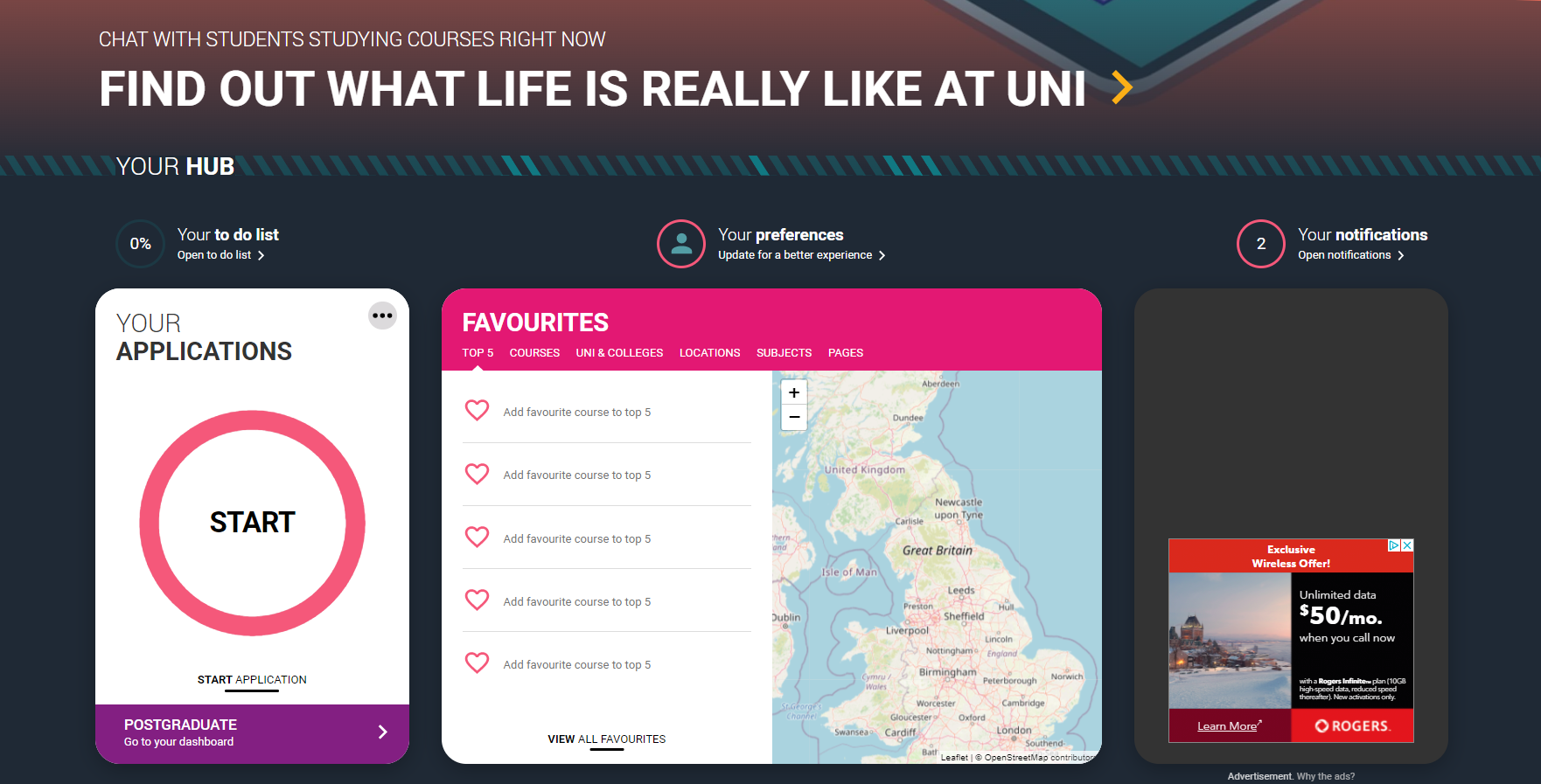
Source: UCAS
Example: Carleton University also takes this approach with the recent launch of Carleton360. The platform provides prospects with an all-in-one space for a smooth enrolment experience. Prospects can customize their settings and specify their areas of interest. The platform automatically gathers and displays key information, including a blurb about the program, relevant student testimonials, admissions news and events, as well as links to the actual application (shown consecutively).
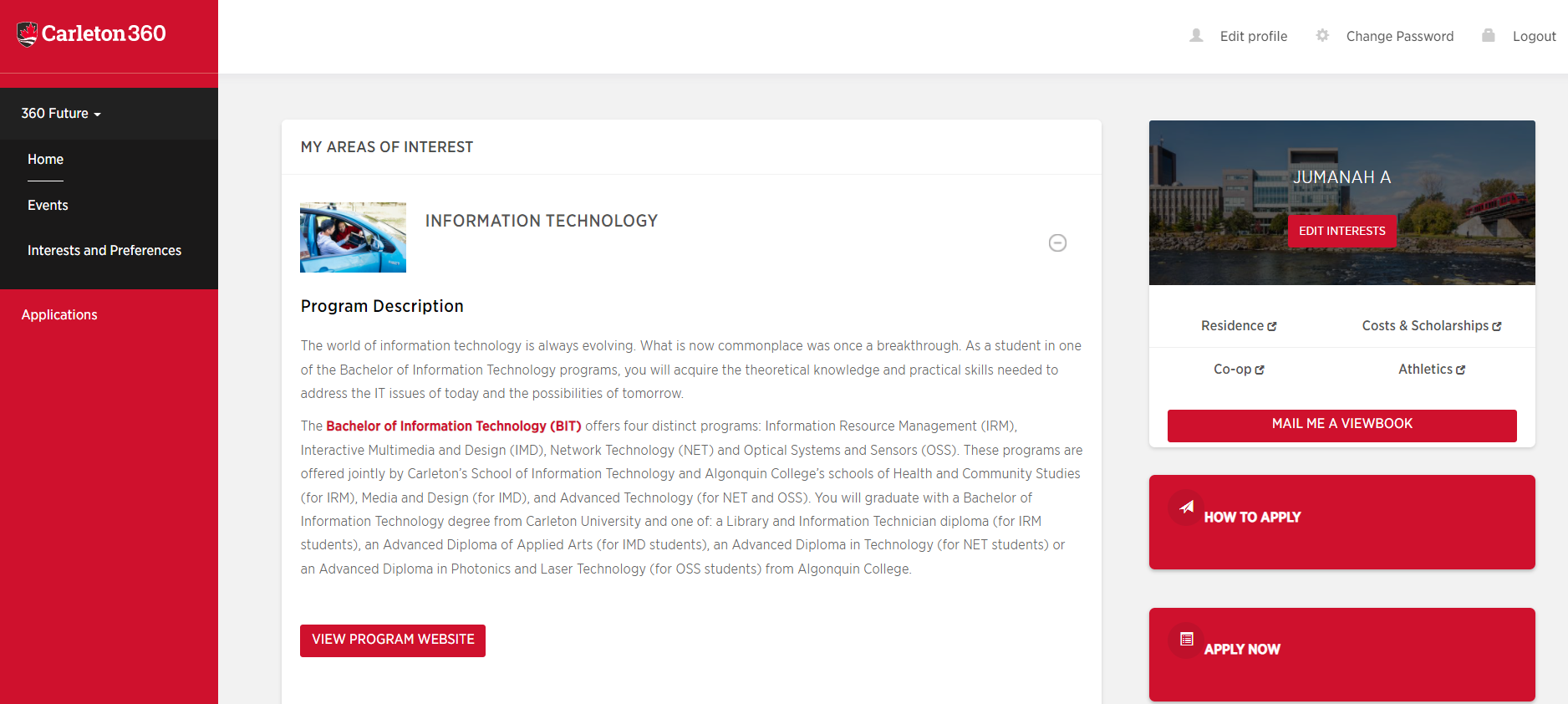

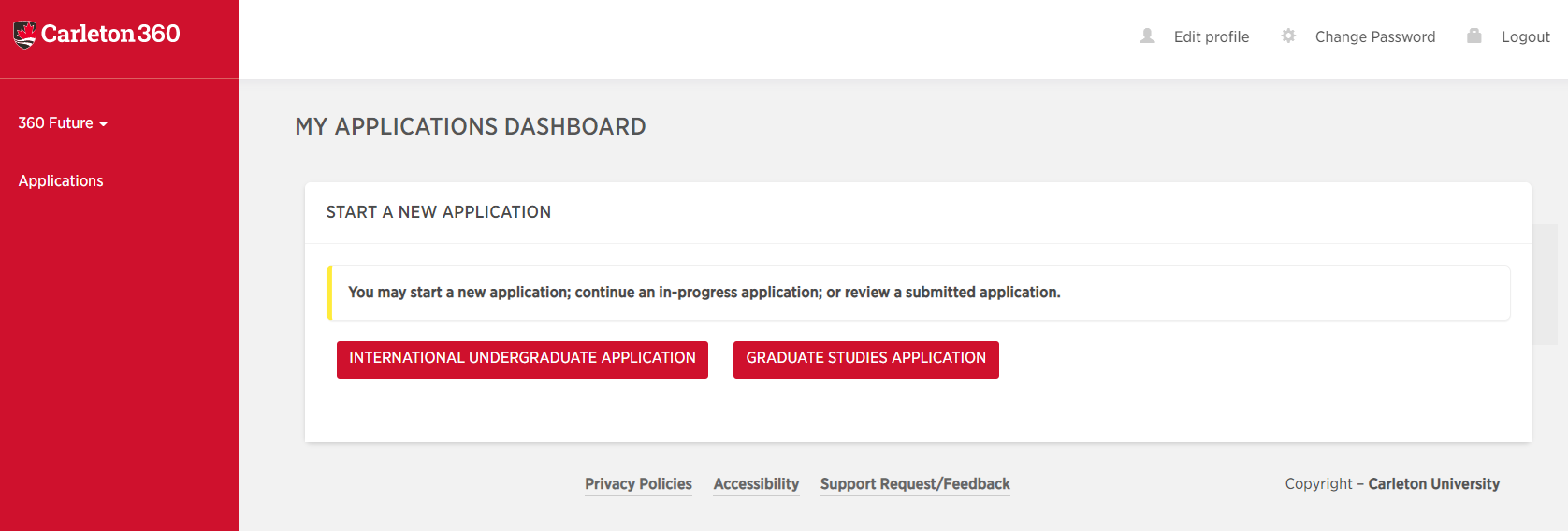
Source: Carleton University
Having everything in one place makes it even easier for prospects to complete their application. In this case, there’s no need to log out to view additional information. It also promotes a positive relationship between prospects and their school—proving that they are more than just a number. By creating these high-quality, customized experiences in the student application portal, schools can better attract and retain interested prospects.
6. Optimize Your Student Portal Features to Improve the Recruitment Process
Recruitment strategies and student expectations have evolved significantly since the pandemic, and they are likely to continue changing over time. For this reason, optimizing your admissions process should always be part of your marketing and student recruitment strategy.
As mentioned above, data can be used to provide your prospects with a memorable and personalized user experience. However, it can also be used to help your school improve its student outreach and student application form. By looking at the data gathered in your student portal, your school can make more informed decisions that positively impact the recruitment process.
For example, HEM’s Student Portal includes monitoring and tracking capabilities that allow schools to identify key performance indicators (KPIs) —from the number of submitted applications to payments and attendance. It also allows schools to enable Google and Facebook tracking to gain even more data insights.
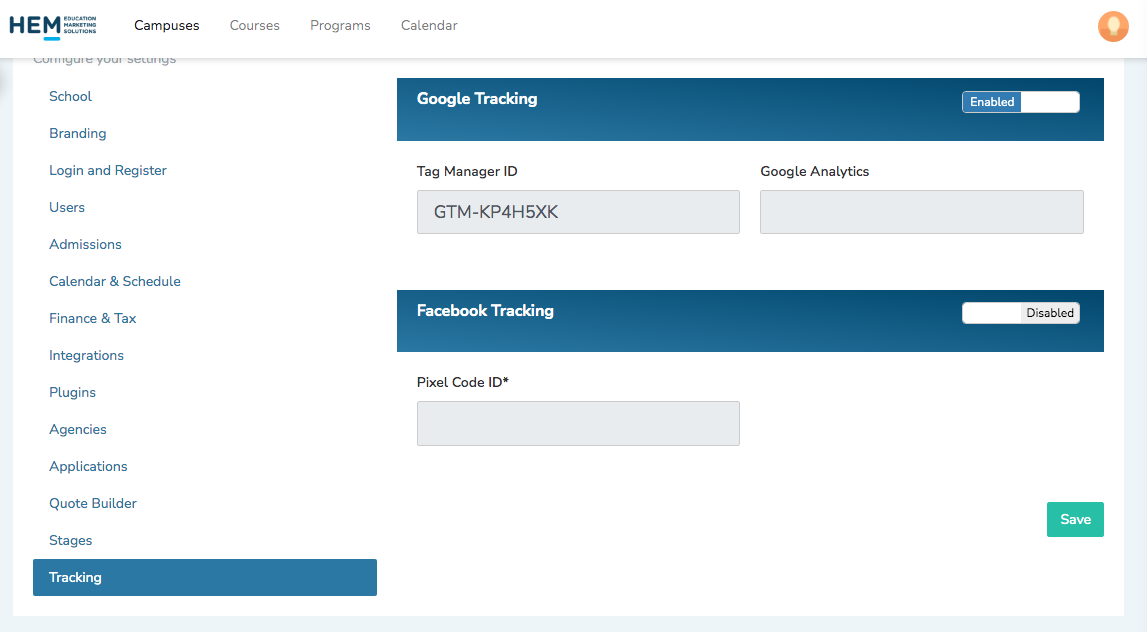
Source: HEM’s Student Portal
To give your school a more competitive edge, you can consider upgrading your student portal to include some of the latest stand-out features. This can include anything from multiple payment gateways and custom fields to mobile-friendliness and software integration.
It’s also important to constantly consider your prospects’ needs and motivations. With this information in mind, you can tailor your admissions process and eliminate any barriers or potential friction points, creating the best student enrolment experience you can provide to keep prospects interested and engaged throughout their journey.


